Category: Labor
Poster Session III
(673) Risk Factors for Obstetrical Hemorrhage Among Nulliparous, Term, Singleton, Vertex Pregnancies
Postpartum hemorrhage (PPH) is an important cause of severe maternal morbidity. Current prediction models do not identify risk factors for PPH among low-risk pregnant patients. Our objective was to evaluate the labor course and identify factors associated with PPH among nulliparous, term, singleton, vertex patients (NTSV) to develop a nomogram to assess risk.
Study Design:
Retrospective cohort study of patients admitted for labor management January 2015-October 2020 at a single tertiary center. Inclusion criteria: nulliparous, term(gestational age ≥ 37/0), singleton, vertex pregnancies admitted for spontaneous labor or induction of labor. Exclusion criteria: scheduled cesarean delivery and patients who delivered precipitously upon presentation. The primary outcome was PPH defined as ≥1000mL. Bivariate analyses and multivariable logistic regression model were used to develop a nomogram for prediction of PPH.
Results:
Of 7,805 NTSV patients, there were 1,395 (17.8%) with PPH. Patients who experienced PPH were on average older, more likely to be non-Hispanic White, have a higher BMI, and a more advanced gestational age at delivery. With adjustment for these demographics, the following factors were independently associated with increased odds of PPH: cervical dilation at admission ≤2, longer length of latent and active labor, shorter length of the second stage, pre-delivery pitocin and chorioamnionitis. PPH was associated with labor courses that required pitocin pre-delivery. Those who presented in spontaneous labor and did not receive pitocin had the lowest rate of PPH (23%), followed by those who had spontaneous labor and received pitocin (31.1%) and by those who had induction of labor (37.8%) P< .001. In our nomogram a score of 20 was associated with ~50% risk of PPH.
Conclusion:
In this analysis, we identified labor findings and events that increase the likelihood of PPH among NTSV deliveries. Avoiding prolonged labor could be a strategy to reduce PPH. Use of this risk assessment nomogram could help to anticipate and clinically prepare for PPH an important strategy to reduce severe maternal morbidity.

AnneMarie E. Opipari, MD (she/her/hers)
Resident Physician
University of Michigan
Ann Arbor, Michigan, United States
AnneMarie E. Opipari, MD (she/her/hers)
Resident Physician
University of Michigan
Ann Arbor, Michigan, United States- EK
Emily Kobernik, PhD
Senior Epidemiologist
CDC Foundation
Atlanta, Georgia, United States 
Molly J. Stout, MD,MSCI
University of Michigan
Ann Arbor, Michigan, United States- EL
Elizabeth S. Langen, MD
Associate Clinical Professor
University of Michigan VonVoigtlander Women's Hospital
Ann Arbor, Michigan, United States - AL
Angela Liang, MD
University of Michigan
Ann Arbor, Michigan, United States - NS
Natalie Saunders, MD
University of Michigan
Ann Arbor, Michigan, United States - DM
Daniel M. Morgan, MD
Professor of Obstetrics and Gynecology and Professor of Urology,
University of Michigan -Von Voigtlander Women's Hospital
Ann Arbor, Michigan, United States

.png)
